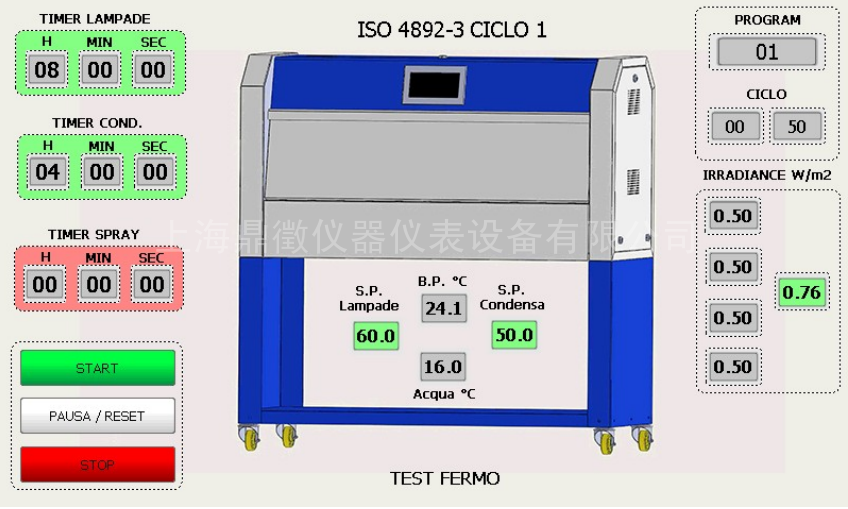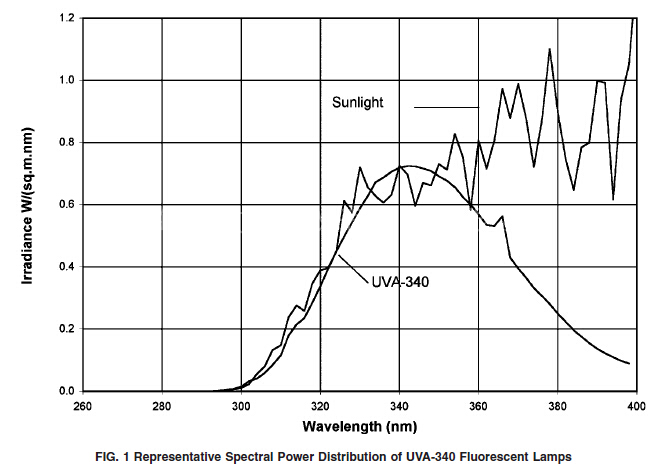
您好, 歡迎來到智慧城市網(wǎng)! 登錄| 免費注冊| 產(chǎn)品展廳| 收藏商鋪|

您好, 歡迎來到智慧城市網(wǎng)! 登錄| 免費注冊| 產(chǎn)品展廳| 收藏商鋪|
13472521719

ASTM D4329測試塑料的熒光紫外線照射。它涵蓋了基于ASTM G151和ASTM G154實踐的特定程序和測試條件。該測試方法還包括測試樣品的制備,適合塑料的測試條件,以及測試結(jié)果的評估。作為聚合物測試服務(wù)的一部分
ASTM D4329使用和要考慮的因素
當(dāng)在室外條件下(例如光,熱和水)暴露時,聚合物的機械,電學(xué)和光學(xué)性能會發(fā)生顯著變化。該方法旨在促使與終使用條件相關(guān)的性質(zhì)變化,包括日光,除了熱量之外的水分的影響。本地化天氣引起的惡化模擬,例如大氣污染,生物攻擊和鹽水暴露,并非由本實踐中使用的暴露所預(yù)期。對于熒光燈和鹽水的組合,您應(yīng)該考慮ASTM D5894。
ASTM D4329測試的典型實驗參數(shù)
樣本/產(chǎn)品數(shù)量:至少三個重復(fù)樣本。
尺寸和形狀:將根據(jù)用于測量曝光對樣品的影響的測試方法的規(guī)格來確定。建議在可能的情況下,將樣品的尺寸設(shè)計成適合樣品架。對于由絕緣材料制成的樣品,例如泡沫,大厚度為20 mm,以便為冷凝提供適當(dāng)?shù)臒醾鬟f。
輻照度水平:但通常從0,49至1,55 W/m²(UVA)
燈泡類型: UVB-313和UVA-340(常見)
曝光持續(xù)時間:待定
曝光周期:
循環(huán)A(一般用途)
B輪(汽車用)
循環(huán)C(聚合物建筑產(chǎn)品)
This standard is issued under the fixed designation D 4329; the number immediately following the designation indicates the year of original adoption or, in the case of revision, the year of last revision. A number in parentheses indicates the year of last reapproval. A superscript epsilon (e) indicates an editorial change since the last revision or reapproval.
1. Scope*
1.1 This practice covers specific procedures and test conditions that are applicable for fluorescent UV exposure of plastics conducted in accordance with Practices G 151 and G 154. This practice also covers the preparation of test specimens, the test conditions best suited for plastics, and the evaluation of test results.
1.2 The values stated in SI units are be regarded as standard. The values given in brackets are for information only.
1.3 This standard does not purport to address all of the safety concerns, if any, associated with its use. It is the responsibility of the user of this standard to establish appropriate safety and health practices and determine the applicability of regulatory limitations prior to use.
NOTE 1—This practice is technically similar to ISO 4892-3.
2. Referenced Documents
2.1 ASTM Standards:
D 3980 Practice for Interlaboratory Testing of Paint and Related Materials
D 5870 Practice for Calculating Property Retention Index of Plastics
E 691 Practice for Conducting an Interlaboratory Study to Determine the Precision of a Test Method
G 113 Terminology Relating to Natural and Artificial Weathering Tests of Nonmetallic Materials
G 141 Guide for Addressing Variability in Exposure Testing on Nonmetallic Materials
G 147 Practice for Conditioning and Handling of Nonmetallic Materials for Natural and Artificial Weathering Tests
G 151 Practice for Exposing Nonmetallic Materials in Accelerated Test Devices That Use Laboratory Light Sources
G 154 Practice for Operating Fluorescent Light Apparatus for UV Exposure of Nonmetallic Materials
G 169 Guide for Applications of Basic Statistical Methods to Weathering Tests
G 177 Tables for Reference Solar Ultraviolet Spectral Distributions: Hemispherical on 37 Degree Tilted Surface
2.2 ISO Standard:
ISO 4892-3 Plastics—Methods of Exposure to Laboratory
Light Sources—Part 3, Fluorescent UV Lamps
2.3 SAE Standard:
SAE J2020 Accelerated Exposure of Automotive Exterior Materials Using a Fluorescent UV and Condensation Apparatus
3. Terminology
3.1 The definitions in Terminology G 113 are applicable to this practice.
4. Significance and Use
4.1 The ability of a plastic material to resist deterioration of its electrical, mechanical, and optical properties caused by exposure to light, heat, and water can be very significant for many applications. This practice is intended to induce property changes associated with end-use conditions, including the effects of sunlight, moisture, and heat. The exposure used in this practice is not intended to simulate the deterioration caused by localized weather phenomena, such as, atmospheric pollution, biological attack, and saltwater exposure.
(Warning—Variation in results may be expected when operating conditions are varied within the accepted limits of this practice. Therefore, no reference to the use of this practice should be made unless accompanied by a report prepared in accordance with Section 8 that describes the specific operating conditions used. Refer to Practice G 151 for detailed information on the caveats applicable to use of results obtained in accordance with this practice.)
NOTE 2—Additional information on sources of variability and on strategies for addressing variability in the design, execution, and data analysis of laboratory-accelerated exposure tests is found in Guide G 141.
4.2 Reproducibility of test results between laboratories has been shown to be good when the stability of materials is evaluated in terms of performance ranking compared to other materials or to a control.5,6 Therefore, exposure of a similar material of known performance (a control) at the same time as the test materials is strongly recommended. It is recommended that at least three replicates of each material be exposed to allow for statistical evaluation of results.
請輸入賬號
請輸入密碼
請輸驗證碼
以上信息由企業(yè)自行提供,信息內(nèi)容的真實性、準(zhǔn)確性和合法性由相關(guān)企業(yè)負責(zé),智慧城市網(wǎng)對此不承擔(dān)任何保證責(zé)任。
溫馨提示:為規(guī)避購買風(fēng)險,建議您在購買產(chǎn)品前務(wù)必確認(rèn)供應(yīng)商資質(zhì)及產(chǎn)品質(zhì)量。